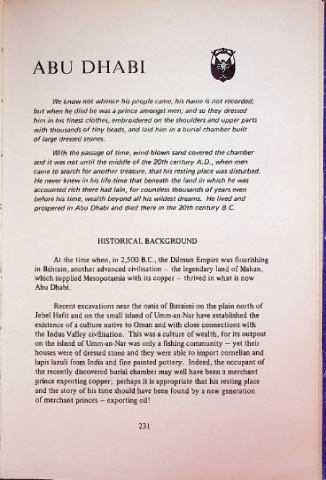Page 234 - The Postal Agencies in Eastern Arabia
P. 234
ABU DHABI
We know not whence his people came; his name is not recorded;
but when he died he was a prince amongst men; and so they dressed
him in his finest clothes, embroidered on the shoulders and upper parts
with thousands of tiny beads, and laid him in a burial chamber built
of large dressed stones.
With the passage of time, wind-blown sand covered the chamber
and it was not until the middle of the 20th century A.D., when men
came to search for another treasure, that his resting place was disturbed.
He never knew in his life-time that beneath the land in which he was
accounted rich there had lain, for countless thousands of years even
before his time, wealth beyond all his wildest dreams. He lived and
prospered in Abu Dhabi and died there in the 20th century B.C.
HISTORICAL BACKGROUND
At the time when, in 2,500 B.C., the Dilmun Empire was flourishing
in Bahrain, another advanced civilisation - the legendary land of Makan,
which supplied Mesopotamia with its copper - thrived in what is now
Abu Dhabi.
Recent excavations near the oasis of Buraimi on the plain north of
Jebel Hafit and on the small island of Umm-an-Nar have established the
existence of a culture native to Oman and with close connections with
the Indus Valley civilisation. This was a culture of wealth, for its outpost
on the island of Umm-an-Nar was only a fishing community — yet their
houses were of dressed stone and they were able to import cornelian and
lapis lazuli from India and fine painted pottery. Indeed, the occupant of
the recently discovered burial chamber may well have been a merchant
7*
prince exporting copper; perhaps it is appropriate that his resting place
and the story of his time should have been found by a new generation
of merchant princes — exporting oil!
231

